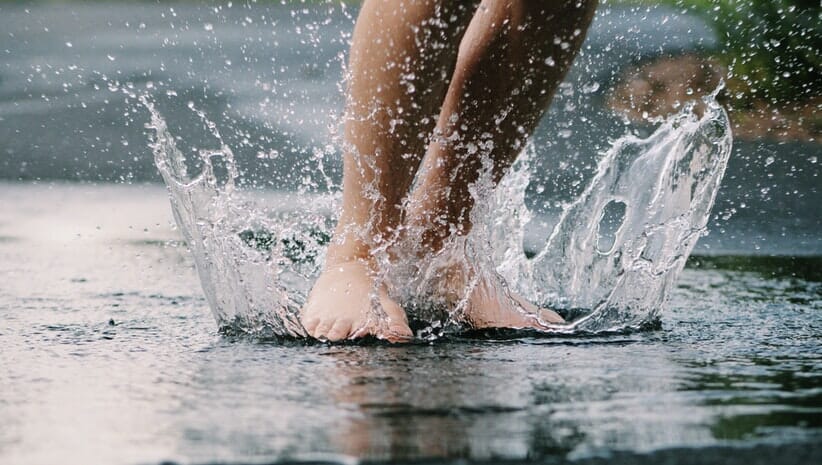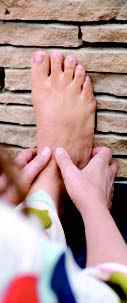Yoga Can Transform How We Use Our Feet
Our connection to our feet is symbolic of our connection to the world around us. Are we tip-toers or stompers? Are we balanced or wobbly? Do those characteristics parallel what we know about our personalities? When a tip-toer enters a room full of strangers, their handshake may be timid and their opinions may be tentative. There is a disoriented feeling about someone who wobbles. A clomper or stomper may be overbearing while a person who feels a balanced connection to the Earth will gracefully adjust to their surroundings. Though it’s not an exact science, we receive information about a person through their body language, including the language of their feet. Yoga can transform how we use our feet, which in turn, can transform how we enter the world. When we engage in practices to support foot care, it has a positive effect on the rest of the body.
Begin Foot Care by Observing Your Feet
Start by observing how you feel about your feet. Many people hate the thought of touching their own feet. Others kick off their flip-flops and pick at their toes during conversations. Many cultures believe that presenting the sole of the foot in any social situation is highly insulting. There are no hard and fast rules about foot etiquette in Southern California but that’s not to say we’re immune to the effect our feet have on others.
A prominent psychoanalytic institute invited a renowned guest speaker to a formal gathering. He removed his shoes and socks and stuffed his bare feet into the host’s sofa. Every psychoanalyst present pondered whether the speaker had anti-social tendencies. Your relationship to your feet may have more of an effect on your social currency than you realize. The relationship your parents had with their feet may also be affecting you; whether they went barefoot in public or even groomed their own feet privately. As adults we have the opportunity to explore, to accept or reject those notions.
We also inherit aspects of our parents’ skeletal structure and are genetically predisposed to carry our weight in familiar patterns on the twenty-six bones of each foot. We unconsciously model our gait on what we see around us during our developmental years.
When a mother duck waddles with her webbed feet pronating, baby ducks imitate, more concerned with eating and socializing than with analyzing mommy’s gait. Thoughts about the effect of alignment in our feet and the rest of our joints may come much later, and unfortunately it may only happen when we feel pain after repetitive activity has compromised ligaments or worn down cartilage.
The Steps We Take Daily
“An average adult takes 5,000 steps per day. Imagine if you bent your finger in a slightly crooked way, 2,500 times per day and did that with 100 pounds of weight on it,” states yoga teacher/physical therapist Sherry Brourman who has broken ground, so to speak, with her cutting edge studies on walking. “Our feet are the main support for the rest of our body. We need to learn how to use them, and they don’t come with instructions,” states Yumana Zake, creator of Yumana Foot Fitness.
The Benefits of Foot Massage for Foot Care
I signed up for a one hour treatment at Lee La Thai Foot Massage and for a reflexology session at Tola Malibu. When the practitioners’ fingers felt for tight spots on the soles of my feet, my nerves carried the message of a deliciously, floating relaxation all throughout my body and face. I felt as if I’d taken a perfect catnap.
The feet, hands and outer ears contain nerve endings which correspond to specific systems and organs in the body. Foot massage has benefits far beyond simple relaxation. In a demonstration of the connection of the feet to the rest of the body, particularly the digestive system, gastroenterologist Dr. Sabine Hazan Steinberg of Malibu Specialty Clinic, cites studies investigating foot massage. In one study, 132 people with dyspepsia (painful digestion, gas symptoms) found foot massage more effective than drugs for relieving symptoms.
Foot massage has also helped colicky babies and adults suffering from irritable bowel syndrome by decreasing the bowel spasms. Like other complimentary and integrative health care practices, foot massage should not be a substitute for a comprehensive work up, diagnosis and treatment plan when serious symptoms are present.
Relate To Your Feet
- Pay attention: Throughout the day notice how you stand, distribute your weight and walk.
- Investigate: Lie on your back with your feet in the air. Balance a block on the sole of your foot. If the four corners of your foot were tires on a car, notice which wheel needs air.
- Look for Symmetry: Press your foot evenly against a wall or a yoga block during seated asanas. Notice the four corners and the difference between one foot and the other.
- Observe: Pick up your favorite old sneakers and check out where the sole is worn down.
- Connect the Joints: Speculate whether pain in your knee, hip or back could relate to your feet.
- Read: A good place to start is Walk Yourself Well by Sherry Brourman or anatomy books by Ray Long.
- Professional foot care: See a podiatrist or primary care physician if you have a contagious condition like foot fungus. Over-the-counter products usually are not strong enough.
- Self Care: Self-massage, soaking the feet in salts or body scrubs, relaxing in a Jacuzzi (if circulation is healthy).


